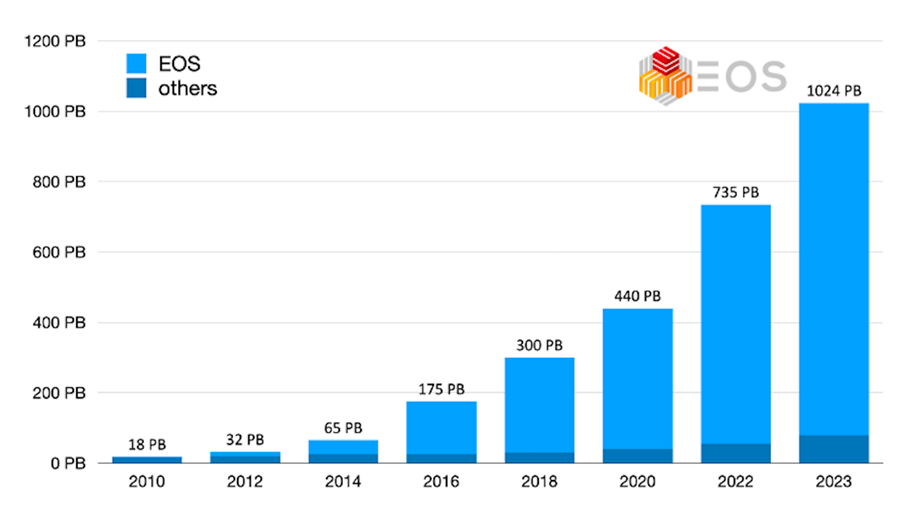CarderPlanet
Professional
- Messages
- 2,552
- Reaction score
- 696
- Points
- 83
CERN is setting a new standard for storing data for future experiments.
CERN, a leading European research center, has expanded its data storage system to more than 1 million terabytes (TB) in total, ahead of a new round of ion collision experiments. Now the total amount of data storage exceeds exabytes (EB), most of which is located on hard drives, although the share of using flash drives is also growing.
CERN explained that increasing capacity is one thing, but it is also important to be able to access data in a timely manner. Thanks to the update, it was possible to achieve a data read speed of 1TB / s, which is a significant achievement in terms of performance.
The upgrade, which adds 289 petabytes (PB) of storage capacity since last year, was performed to support the latest round of heavy ion experiments at CERN's 27-kilometer-long Large Hadron Collider. Experiments involve colliding heavy ions at almost the speed of light to study the basic building blocks of the known universe.
The tests, which will be conducted over several years at the ring particle accelerator near Geneva, Switzerland, are expected to produce a huge amount of data — more than 600 PB-that must be processed before being sent for long-term storage on magnetic tapes.
While a petabyte of data may seem like a lot, thanks to the high-capacity storage enclosures, it doesn't take up as much physical space. Now it is possible to fit a petabyte of storage in one case. However, an exabyte of storage is a completely different matter, requiring rows of racks full of disk shelves.
The CERN storage system includes approximately 111,000 devices, most of which are hard drives, but with an increasing number of flash drives. The systems run on EOS, an open source platform developed by CERN for use with the Large Hadron Collider and other scientific tasks.

Increased storage volumes since 2010
Note that to reach the 1 exabyte mark, you will need 100,000 disks with a capacity of 10 TB, but such an array was not created overnight. In fact, storage capacity has grown 56 times over the original 18 PB storage system in 2010, and from 2020 to today, the system's capacity has increased more than 2 times.
When there are more than 100,000 disks, drive failures are common. Previously, CERN replaced 30 failed disks every week, which required resilience planning using various data replication techniques.
CERN, a leading European research center, has expanded its data storage system to more than 1 million terabytes (TB) in total, ahead of a new round of ion collision experiments. Now the total amount of data storage exceeds exabytes (EB), most of which is located on hard drives, although the share of using flash drives is also growing.
CERN explained that increasing capacity is one thing, but it is also important to be able to access data in a timely manner. Thanks to the update, it was possible to achieve a data read speed of 1TB / s, which is a significant achievement in terms of performance.
The upgrade, which adds 289 petabytes (PB) of storage capacity since last year, was performed to support the latest round of heavy ion experiments at CERN's 27-kilometer-long Large Hadron Collider. Experiments involve colliding heavy ions at almost the speed of light to study the basic building blocks of the known universe.
The tests, which will be conducted over several years at the ring particle accelerator near Geneva, Switzerland, are expected to produce a huge amount of data — more than 600 PB-that must be processed before being sent for long-term storage on magnetic tapes.
While a petabyte of data may seem like a lot, thanks to the high-capacity storage enclosures, it doesn't take up as much physical space. Now it is possible to fit a petabyte of storage in one case. However, an exabyte of storage is a completely different matter, requiring rows of racks full of disk shelves.
The CERN storage system includes approximately 111,000 devices, most of which are hard drives, but with an increasing number of flash drives. The systems run on EOS, an open source platform developed by CERN for use with the Large Hadron Collider and other scientific tasks.

Increased storage volumes since 2010
Note that to reach the 1 exabyte mark, you will need 100,000 disks with a capacity of 10 TB, but such an array was not created overnight. In fact, storage capacity has grown 56 times over the original 18 PB storage system in 2010, and from 2020 to today, the system's capacity has increased more than 2 times.
When there are more than 100,000 disks, drive failures are common. Previously, CERN replaced 30 failed disks every week, which required resilience planning using various data replication techniques.
